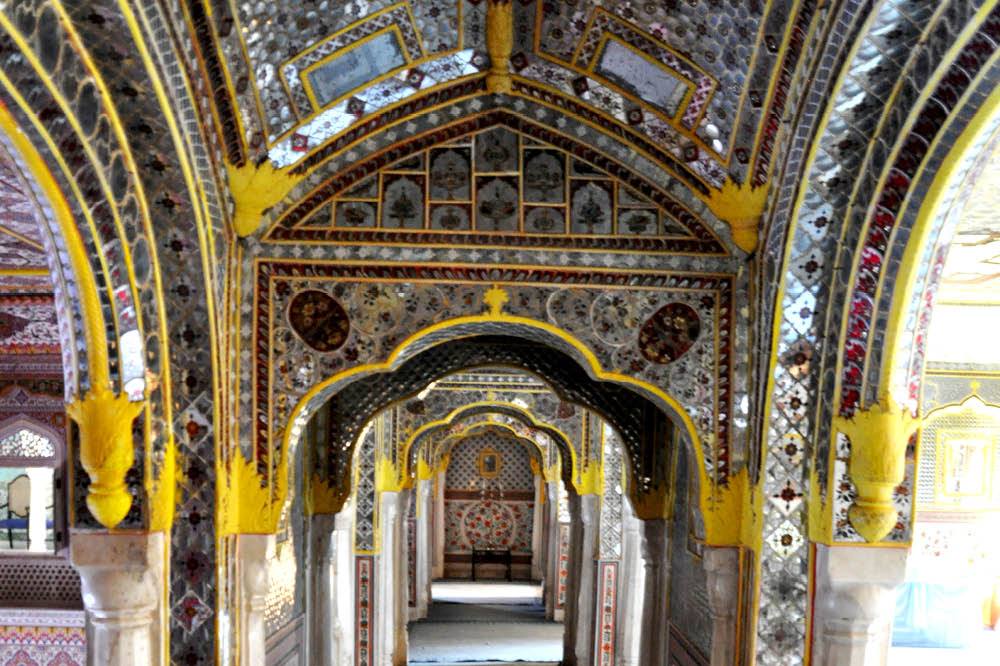ZENANAS ARE A SECRET WORLD OF MODESTY, SECLUSION, PRIVACY AND UNEXPECTED SPLENDOR.
The word “zenana” means women’s quarters or women’s space in Persian, Hindi and Urdu. They flourished in India’s Mughal society architecture, which synthesized Persian and Arabic traditions with indigenous Islamic design and its Indian counterparts.
Back then, women of high social status rarely left the house and were almost never in public. To my eyes, today’s covered women take the zenana with them in the form of resplendent headscarves or veils made in beautiful materials. The custom of fabulously appointed zenanas wasn’t available to everyone, though even small family palaces usually had one.
Modern eyes might see a zenana as oppressive or perhaps blissfully free of the male gaze. To me, each is a paradise carved in stone, then embellished with miraculous finishes. Persian and Arabic traditions are alive in these secret places—fascinating social documents—full of unique design solutions, high craft and the infinite play of light.




Some of the super-distinctive elements of Raj, (Indian, Indo-Islamic and Islamic) architecture were design solutions to both climate and traditional beliefs about a woman’s life. The first problem is how do you create a livable structure for high-status women who cannot be seen in public? Where can children play? How do you make low-light rooms livable and inviting? In other words, how do you allow royal women to observe parties or everyday street life without being seen?
On top of that, the ideal zenana must also be a beautiful, practical, version of paradise. Each chamber might have frescoes of semi-precious jewel dust or be studded with real stones. Other ornaments could be hyper-masculine, martial objects such as decorated pistols, swords or cannons to honor the Nawab. They might feature balconies, alcoves, colored windows or intricately designed tiled floors and walls.
On the advice of an in-the-know design writer (with one of the best, most knowledgeable and personal blogs about interior design, good living and interesting people: TheStyleSaloniste.com), I spent one of life’s best days outside of Jaipur at the Samode Palace. The Samode Palace is still a family home, which happens to be a small-ish palace and is now a heritage hotel.
The management was kind enough to let me tour its conserved, but un-retouched zenana. Jaipur’s pink Palace of the Winds has another knockout zenana. But the Samode Palace still had the look of a place where you could imagine the bustle of party preparations and tranquility of domestic life.
THE ZENANA AND LIGHT
If someone asked you today how to bring non-electrified light into a room, chances are you’d answer, “mirrors”. These zenanas have incredibly high levels of craft, innovation and beauty….the perfect expression of material as metaphor.
Let’s move inside. The architectural sequencing of a zenana's rooms almost always move from quasi-public, where the women can see out... to very, very private, (which means solid walls with few windows and thus, low light). Near the back walls you’ll usually find that light needs to be amplified for the room to be livable. And, this is where the mirror craft reaches its most sublime effects.



INDIVIDUAL MIRROR ELEMENTS ARE EITHER CUSTOM POURED INTO A SHAPE OR CUSTOM FORMED WITH HEAT. NEXT, THEY'RE HAND CUT, BEVELED AND FITTED TO A COMPOUND-CURVED, IRREGULAR SURFACE.
Each one of these mirrors is either custom poured into a shape or custom formed with heat, then hand cut and fitted to a compound-curved, irregular surface. Then, it is faceted or beveled and polished so that the light isn’t fractured by jagged edges. In the best work, the mirror appears to have been poured to create the perfect concave or convex surface to accomplish an intentional design effect. It is challenging to post about something as historical as a zenana without including the politics...so I'll avoid the subject completely except to say, "cloistered"? Yes. Uncomfortable and unpleasant? Not at all.






